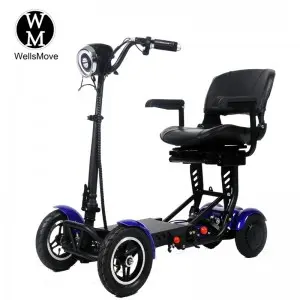Are Electric Tricycles Legal in the US?
Electric tricycles, often referred to as e-trikes, have gained significant popularity in the United States as a versatile, eco-friendly, and cost-effective mode of transportation. They offer a unique combination of stability, ease of use, and efficiency, making them suitable for a wide range of applications, from urban commuting to recreational riding. However, one of the most common questions among potential buyers and users is whether electric tricycles are legal in the US. This comprehensive guide aims to provide a detailed overview of the legal landscape surrounding electric tricycles in the United States.
Federal Regulations
At the federal level, electric bicycles, including tricycles, are regulated by the Consumer Product Safety Commission (CPSC). According to the CPSC, a “low-speed electric bicycle” must meet the following criteria:
Pedals: Fully operable pedals for manual propulsion.
Motor Power: An electric motor with a power output of less than 750 watts (approximately 1 horsepower).
Maximum Speed: A top speed of 20 mph when powered solely by the motor on flat ground.
If an electric tricycle meets these conditions, it is classified as a bicycle under federal law and does not require registration, a license, or adherence to motor vehicle safety standards。
While federal laws set the baseline, they leave room for states to enforce additional rules that may vary based on the tricycle’s design and intended use。
State-by-State Regulations
Each state in the US interprets and enforces electric tricycle regulations differently. This means that riders must understand their local laws to ensure compliance. Here’s a general overview of how states classify and regulate e-trikes:
The Three-Class System
Many states, such as California and New York, use a three-class system to regulate electric bicycles, which may also apply to electric tricycles:
Class 1: Pedal-assist only, with motor support ceasing at 20 mph.
Class 2: Equipped with a throttle, also capped at 20 mph.
Class 3: Pedal-assist only, with motor support up to 28 mph. These are often restricted from bike paths or multi-use trails.
E-trikes that fall under Class 1 or Class 2 are generally allowed on bike paths, shared-use trails, and even sidewalks in some areas, while Class 3 models are more restricted。
Helmet and Age Requirements
Some states, such as Pennsylvania, require helmets for riders under 18. In contrast, others mandate helmets for all users of Class 3 electric vehicles. Age restrictions may also apply, particularly for higher-speed models。
Road Use
Most states allow e-trikes on public roads but require riders to obey traffic laws, such as staying within bike lanes and yielding to pedestrians. States like Oregon and Colorado provide clear guidelines for where you can ride, from city streets to multi-use paths。
Licensing and Registration
For the majority of e-trikes that meet federal and state definitions, no special license or registration is required. However, exceptions exist:
Alaska: Treats e-trikes as motor-driven cycles, necessitating licensing and registration.
North Dakota: Requires registration for certain motorized bicycles, including e-trikes.
It is crucial to check with your local Department of Motor Vehicles (DMV) to confirm whether licensing or registration applies in your state。
Can You Ride on Sidewalks and Bike Lanes?
Whether you can ride an e-trike on sidewalks or in bike lanes largely depends on state and local laws. Here’s a general guideline:
Sidewalks: Some states allow e-trikes on sidewalks, especially in areas without designated bike lanes. However, many cities restrict sidewalk usage to pedestrians for safety reasons.
Bike Lanes and Multi-Use Paths: Most Class 1 and Class 2 e-trikes are permitted in bike lanes and on multi-use trails, but some Class 3 models may be restricted due to their higher speeds.
Always verify local ordinances before heading out to avoid fines or citations。
Equipment Requirements
To ensure safety and compliance, most states require e-trikes to have the following:
Lights: Front white light and rear red reflector or light for nighttime riding.
Brakes: Functional braking systems capable of stopping within a reasonable distance.
Audible Devices: A bell or horn to alert pedestrians.
By equipping your e-trike with these essentials, you enhance safety while adhering to state laws。
Advantages of E-Trike Legality
The legal recognition of e-trikes as bicycles under federal and most state laws offers several advantages:
Ease of Access: No need for a driver’s license or registration in most states.
Cost-Effective Transportation: Avoid fuel costs, parking fees, and insurance premiums.
Environmentally Friendly: Reduce your carbon footprint with zero-emission commuting.
Inclusive Mobility: Perfect for individuals of all ages and abilities, offering stability and ease of use.
Challenges to Consider
Despite their legality, navigating the regulatory landscape can be challenging. Variations in local laws may restrict where and how you can use an e-trike, so it’s essential to stay informed. Additionally, heavier or faster e-trikes may fall into gray areas that require clarification from local authorities。
Tips for Staying Legal
Know Your Class: Determine whether your e-trike is classified as Class 1, 2, or 3.
Check Local Laws: Consult your city or state transportation website for specific regulations.
Equip Your Trike: Ensure it has the necessary lights, brakes, and safety features.
Be Courteous: Yield to pedestrians, use bike lanes when available, and follow traffic laws。
Conclusion
Electric tricycles are a game-changer in personal mobility, offering a practical, eco-friendly alternative to traditional transportation. While navigating their legal status may seem daunting, understanding federal and state laws ensures a safe and enjoyable riding experience. By staying informed and compliant, you can confidently hit the road with your e-trike and enjoy the freedom it offers。
Post time: Aug-13-2025



